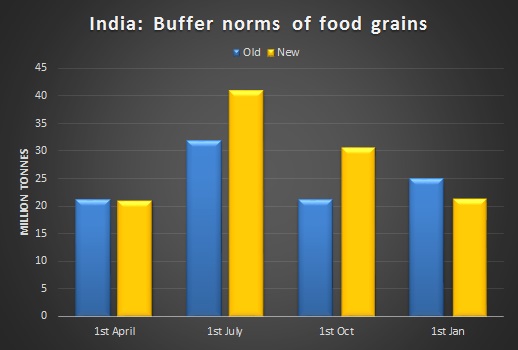
India increases buffer norms for food grains; Excess stock to be exported
 It is estimated that India wastes around 4 – 6% of cereals mainly due to poor storage facilities and transport
It is estimated that India wastes around 4 – 6% of cereals mainly due to poor storage facilities and transportThe Cabinet Committee on Economic Affairs (CCEA), chaired by the Prime Minister Narendra Modi has approved the revision of buffer norms for food grains in the Central Pool. The Committee has also said that in case the stock of food grains in the Central Pool is more than the revised buffer norms, the Department of Food and Public Distribution will offload excess stock in the domestic market through open sale or through exports. For this purpose, an Inter-Ministerial Group consisting of Secretary, Department of Food & Public Distribution, Secretary, Expenditure and Secretary, Consumer Affairs has been constituted. This will ensure better management of food stocks in the country, said the government. The present buffer norms for food grains in the Central Pool are in existence since April, 2005. The off take of food grains under the Targeted Public Distribution System has increased significantly in the last few years. Further, the National Food Security Act has also come into force with effect from July 5, 2013.
 Source – Food Ministry, India
Source – Food Ministry, IndiaCentral agencies, including the Food Corporation of India (FCI) will now have to procure more food grains, particularly during the off-season. According to the new buffer norms, the minimum volume of food grains as of 1st of July has been increased by over 9 million tonnes from 31.9 to 41.12 million tonnes, while buffer norms as of 1st October have been increased by over 9.5 million tonnes from 21.2 to 30.77 million tonnes. However, buffer norms as of 1st January have been reduced from 25 million tonnes to 21.41 million tonnes. The move is expected to restrict food grain supply in the domestic market and for exports, as production is expected to drop this year due to adverse weather conditions. According to government estimates, the production of total kharif food grains in India is expected to reach 120.27 million tonnes during 2014-15, which is down about 7% y/y. India is both the world’s largest producer and exporter of cereals. India’s export of cereals (mainly rice and wheat) in FY2013-14 stood at around $10.5 billion, which is up about 65% from around $6.4 billion recorded in FY2011-12. Major export destinations for Indian cereals include Iran, Saudi Arabia, Indonesia, UAE and Bangladesh.
This article was published on January 17, 2015.





 to success.
to success.